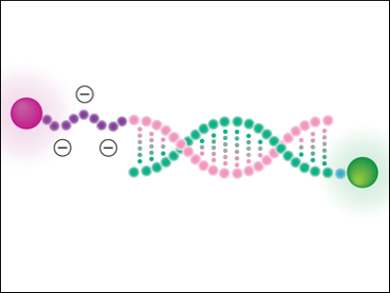Switch-on fluorescent probes have become increasingly attractive for biological samples due to the stimuli-dependent increase in their fluorescence signal. As the signal is dependent on concentration, there is a need to normalize the signal to the amount of fluorophores present. Combining a stimuli-responsive dye with a stably emitting reference dye allows for distinguishing the concentration effect against the switch-on effect. These combinations are known as ratiometric dyes.
Jean-Christophe Leroux, Swiss Federal Institute of Technology (ETH) Zurich, Switzerland, Paola Luciani, ETH Zurich and University of Jena, Germany, and colleagues have created an extracellular ratiometric reactive oxygen species (ROS) sensor by coupling the ROS-responsive cyanine dye Cy5 and the stably emitting Chromis500 dye. Cy5 has a very low quantum yield in its reduced form (HCy5), which can be oxidized by ROS.
The team found that complementary peptide–nucleic acids (PNA) are ideal linkers (pictured). The two strands can be prepared separately, thereby allowing for more flexibility in the respective synthetic routes. Cy5 was linked to the PNA via polyethylene glycol—polyglutamate moieties to inhibit cell internalization (pink strand). Chromis500 was linked directly to the complementary PNA via condensation with a lysine group (green strand). After reduction of Cy5 to HCy5, the two PNA strands were annealed.
The researchers assessed the ROS-sensing ability of the dye and showed a 1.3-fold to 2.2-fold increase in the Cy5/Chromis500 signal ratio upon incubation with superoxide anion in cell-free systems or with H2O2-stimulated cells.
- Development of a Modular Ratiometric Fluorescent Probe for the Detection of Extracellular Superoxide,
Diana Andina, Davide Brambilla, Noah Munzinger, Jasmine Frei, Cristina Zivko, Jean-Christophe Leroux, Paola Luciani,
Chem. Eur. J. 2017.
DOI: 10.1002/chem.201700563




